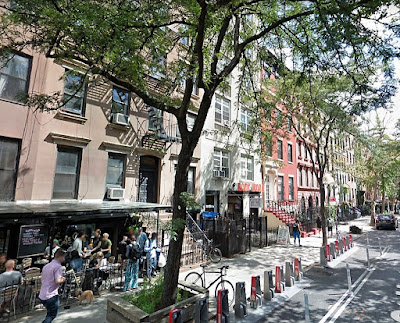 |
| from Valentine's Manual of New York 1857 (copyright expired) |
Manhattan Island above the established city was dotted with sprawling summer estates in the mid-18th century. Sitting among the verdant hills near the East River in what would become the East Village and Kips Bay districts were the estates of the Keteltas, Watts and Kips families. The mansion of the Petrus Stuyvesant, family, however, was a year-round residence.
Erected sometime before 1765, the stately Georgian style home was nestled among sumptuous gardens and surrounded by the outbuildings necessary to maintain the estate. Located at what would become 8th Street, between First and Second Avenues, its exuded a sense of grandeur. Nearly a century later, the 1861 book New York City During the American Revolution remembered it as "a fine hip-roofed mansion with a lofty portico."
The visible presence in the extended Stuyvesant family in the area could be traced to Peter Stuyvesant the Director General of the West India Company in New Netherlands. On March 12, 1651 he purchased land for his farm, or bouwerij, far to the north of New Amsterdam. The deal included, actually, two properties—Bowery (as the Dutch word became anglicized) #1 on which Stuyvesant constructed his home, and a portion of Bowery #2. The combined farm encompassed all of the land from today's Fourth Avenue to the river, from 5th to 17th Streets.
 |
| from the collection of the Museum of the City of New York |
Among the famous director's great-grandchildren was Petrus (also known as Peter). He was born in 1727 to Gerardus Stuyvesant and Judith Bayard. He and his wife, the former Margaret Livingston (familiarly known as Peggy) had three children, Judith, Cornelia, and Nicholas William.
Judith was born on Christmas Day, 1765, around the time the mansion was completed. Nicholas, the youngest of the three children, came along about four years later.
Nicholas married Catherine Livingston Reade on January 31, 1795. Following his father's death on August 31, 1805, he inherited the estate. The couple had produced a teeming family--Peter, Nicholas William, Jr., John Reade, Gerard, Robert Reade, Joseph Reade, Catharine Ann, Helen, and Margaret Livingston Stuyvesant.
 |
| American artist Tabea Hosier created this charming primitive depiction of the mansion around 1935. from the collection of the National Gallery of Art |
Wealthy landowners realized the end of a gracious period was drawing to a close, and even the powerful Stuyvesant name would not stave off progress forever. It would be 18 years, however, before Nicholas gave up ownership of the roadway that now cut in front of his mansion. On October 19, 1829 The Street Committee of the City of New York accepted Nicholas Stuyvesant's "Cession of that Part of Eighth Street lying between the second and third Avenues."
Within two years developer Thomas E. Davis began erecting fashionable brick-faced rowhouses along the block. To add exclusivity to the enclave, he was instrumental in having the street renamed St. Mark's Place.
Nicholas William Stuyvesant died in the mansion on March 1, 1833. Although Catherine would survive to the age of 85, dying in 1863, her family was quick to sell the estate. Within the year demolition of the house commenced. Around 1835 the knoll upon which it stood was leveled.
 |
| The block as it appears today. |
.png)
No comments:
Post a Comment